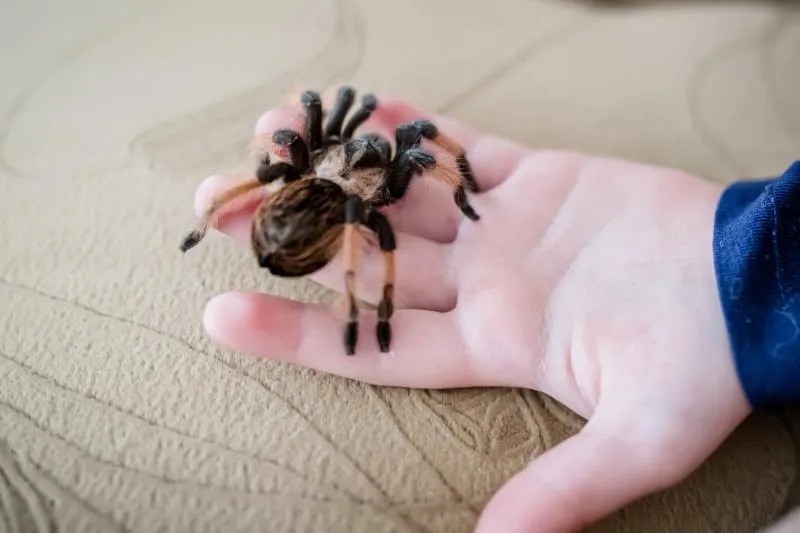Appearance of the Mexican Redknee Tarantula
The Mexican Redknee Tarantula (Brachypelma hamorii), a captivating species, is a popular choice for tarantula enthusiasts. Known for its striking appearance, this spider is easily identifiable by its vibrant coloration and distinctive markings. Their overall look makes them a fascinating creature to observe and care for. As a species, the Mexican Redknee tarantula is relatively docile, making them suitable for beginner spider keepers who are learning about arachnid care and behavior. They are also known for being a long-lived species, which makes them a rewarding pet for many. The contrast of colors, coupled with their manageable size and temperament, makes them a highly sought-after species within the pet trade. Understanding their physical traits helps in appreciating their unique beauty and identifying their needs.
Size and Physical Traits
Adult Mexican Redknee Tarantulas are medium to large-sized spiders. Females are generally larger than males. The body length, excluding legs, can reach up to 2 to 3 inches (5 to 7.6 cm). With a full leg span, they can measure up to 5 to 6 inches (12.7 to 15.2 cm). Their bodies are covered with hairs, which provide sensory information and help them to navigate their surroundings. These spiders have eight legs, two pedipalps (used for sensing and manipulating food), and two chelicerae (fangs) used for injecting venom. When observing these tarantulas, the size and structure of their body provide a remarkable insight into their lifestyle and survival strategies. The sturdy build of the spider complements their terrestrial nature, enabling them to move comfortably on various surfaces.
Coloration and Markings
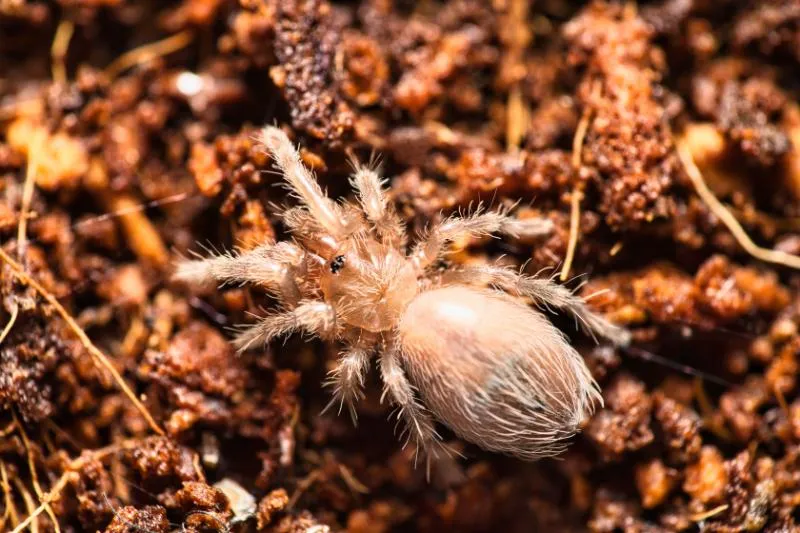
The Mexican Redknee Tarantula is renowned for its striking coloration. Their defining feature is the vibrant red-orange markings on their leg joints, which contrast dramatically against their black legs. The carapace (the top part of the cephalothorax) is typically a muted bronze or tan color. The abdomen is covered in dark hairs, often with reddish hues. This coloration serves as a warning signal to potential predators. The striking red and black pattern of these spiders is a key characteristic. These colors are not only beautiful, but also serve a functional purpose, helping them to blend into their natural environment and warn off predators with their bold appearance. The visual appeal of the Mexican Redknee makes it a favorite among enthusiasts.
Habitat and Native Range
Understanding the natural habitat of the Mexican Redknee Tarantula is essential for providing proper care. These tarantulas are native to the Pacific coast of Mexico, specifically the states of Guerrero and Michoacán. Their habitat is characterized by dry scrublands, tropical deciduous forests, and areas with a moderate amount of rainfall. In the wild, they are typically found in burrows, which they create or find under rocks, logs, or in the soil. These burrows provide protection from predators and the harsh elements. As a ground-dwelling species, they are well-adapted to the terrestrial environment. Replicating their natural habitat in captivity is a key component of successful tarantula care, ensuring their physical and psychological well-being. Learning about their wild environments provides a great appreciation for these creatures and their conservation.
Natural Environment
Mexican Redknee Tarantulas are primarily found in the arid and semi-arid regions of western Mexico. Their natural habitat offers a variety of microclimates, from scrublands with sparse vegetation to forested areas. They are well-adapted to survive in environments where the temperature can fluctuate significantly between day and night. These tarantulas are predominantly nocturnal, emerging from their burrows at dusk to hunt for food. The ground composition, which includes dry soil, rocks, and sparse vegetation, offers excellent camouflage and cover from predators, such as birds and other large animals. The environment also provides the necessary conditions to maintain their burrows, which serves as a safe space to molt and rest. Their survival hinges on their ability to live in a challenging landscape.
Geographic Distribution
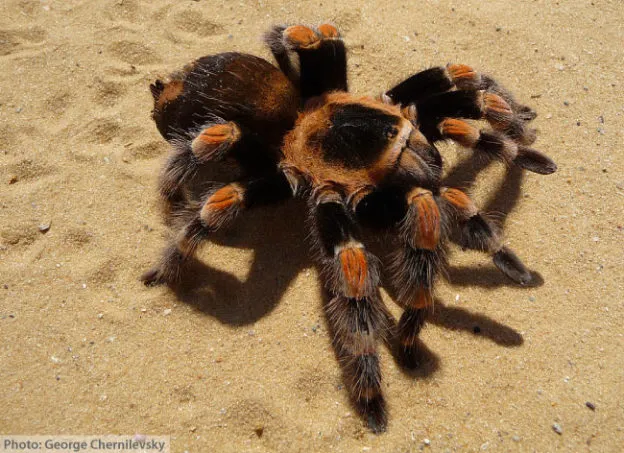
The geographic distribution of the Mexican Redknee Tarantula is limited to a specific area along the Pacific coast of Mexico. Their presence is concentrated in the states of Guerrero and Michoacán, where they thrive in the ecological conditions. The boundaries of their range are defined by the availability of suitable habitats and the absence of environmental pressures. Knowledge of their range is important for conservation efforts and for preventing over-collection. These tarantulas’ distribution is crucial when observing the biodiversity in the region. Because of the popularity of the species in the pet trade, it is important to consider the ethical and environmental implications of their collection and trade. Supporting conservation projects will help ensure that these tarantulas continue to thrive in their natural environment.
Behavior and Temperament
Mexican Redknee Tarantulas are generally known for their docile and manageable temperament, which makes them popular pets. They are relatively slow-moving spiders that spend most of their time in their burrows or hiding places. While they are not typically aggressive, they will defend themselves if threatened. Understanding their behavior is crucial for proper handling and care. These tarantulas are crepuscular or nocturnal, meaning they are most active during the evenings and nights. Their behavior can be observed by studying their interactions, which offers insight into their social dynamics, feeding habits, and responses to the environment. Their temperament makes them suitable for beginner spider keepers, provided that certain precautions are taken. Always be mindful when handling these spiders to ensure the well-being of the tarantula.
Typical Behavior
The typical behavior of a Mexican Redknee Tarantula includes spending much of their time in their burrows, especially during the day. They are ambush predators, waiting patiently for prey to come close. When they are not hiding, they might be seen moving around their enclosure in search of food or a mate. They are relatively slow-moving and do not often attempt to bite unless provoked. During molting, they are particularly vulnerable and will hide until their new exoskeleton hardens. Understanding their behavior is key to creating a suitable habitat. Their routines may vary depending on environmental factors, such as temperature and humidity. Their temperament makes them suitable for beginner spider keepers.
Defense Mechanisms
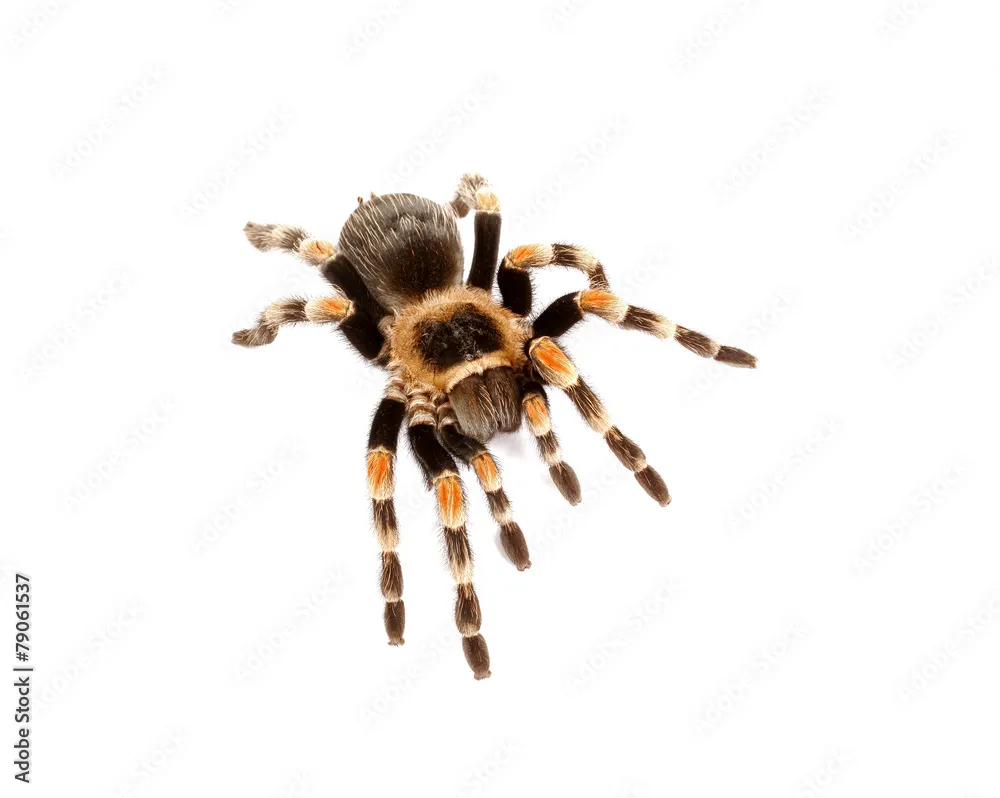
Mexican Redknee Tarantulas have several defense mechanisms to protect themselves from predators. One of their primary defenses is the urticating hairs located on their abdomen. When threatened, they can flick these hairs towards potential predators. These hairs cause intense itching and irritation upon contact with the skin. They may also bite as a last resort. Their bite is not deadly to humans. In addition to physical defenses, they also use their coloration as a warning signal. The bright red markings on their legs serve as a visual deterrent. They will often try to flee or hide first. Understanding the defense mechanisms allows keepers to handle these spiders safely.
Diet and Feeding Habits
Mexican Redknee Tarantulas are carnivores. They feed primarily on insects, although they will eat small vertebrates in the wild. Their diet in captivity typically consists of crickets, mealworms, and cockroaches. They have strong jaws and fangs that they use to capture and inject venom into their prey. Their diet is simple in the wild. They can also be opportunistic feeders and will eat anything they can overcome. Providing a varied diet ensures that they receive the necessary nutrients to stay healthy and thrive. Maintaining a healthy diet is essential for the tarantula’s overall well-being and longevity.
What They Eat
The primary diet of the Mexican Redknee Tarantula in the wild consists of insects. Crickets, grasshoppers, and beetles are among their favorite foods. In captivity, they can eat crickets, mealworms, and roaches. They also consume other invertebrates. The size of the prey should be appropriate for the tarantula’s size, so the prey is not too big. Spiderlings need smaller prey items like pinhead crickets. Adults can eat larger prey like adult crickets. Feeding them a variety of prey items ensures they receive a balanced diet. Always ensure that food items are free of pesticides and chemicals.
Feeding Frequency

The feeding frequency of a Mexican Redknee Tarantula depends on its age. Spiderlings require more frequent feedings, typically every other day. Juvenile tarantulas should be fed every 3-7 days, while adult tarantulas can be fed every 7-14 days. Overfeeding should be avoided. The spider’s abdomen should be a healthy size and not excessively large. Monitoring the tarantula’s behavior and appetite can help determine the proper feeding schedule. During the molting process, they may stop eating. Feeding frequency also depends on the tarantula’s individual metabolism and the environmental conditions.
Lifespan and Reproduction
Mexican Redknee Tarantulas are known for their relatively long lifespans, which makes them a rewarding pet for arachnid enthusiasts. The females typically live for 10 to 25 years, whereas males have a shorter lifespan of approximately 5 to 10 years. Understanding their lifespan is important when considering them as a pet. Reproduction is a fascinating aspect of their life cycle. This includes the mating behavior and egg-laying process. The long lifespan of the female Mexican Redknee Tarantula is a key factor in their appeal as pets. Responsible breeding practices are important for preserving the species.
Lifespan in Captivity
In captivity, the lifespan of Mexican Redknee Tarantulas is generally similar to their lifespan in the wild. Females can live for 10 to 25 years, whereas males tend to live for 5 to 10 years. Factors that affect their lifespan include proper care, diet, and environmental conditions. Providing a suitable habitat and a varied diet are key factors in maximizing their lifespan. Regular health checks and monitoring for signs of illness are also important. The long lifespan makes them a rewarding pet for those who are prepared to provide long-term care. By replicating their natural environment, you can increase their longevity.
Mating and Egg Laying
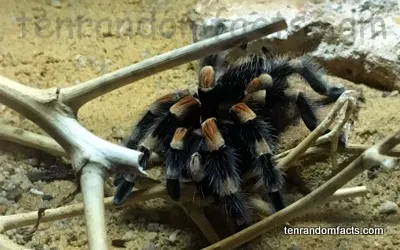
The mating process of Mexican Redknee Tarantulas is a remarkable display of arachnid behavior. Male tarantulas mature and develop mating spurs on their front legs. They seek out a receptive female by drumming on her burrow or web. The male will deposit sperm webs. The female will then take the sperm into her spermatheca. After mating, the female will lay eggs inside a silken egg sac. The egg sac can contain hundreds of eggs, depending on the female’s size and age. The female will fiercely guard the egg sac until the spiderlings hatch. This fascinating life cycle is a testament to the intricate behaviors of these spiders.
Conservation Status and Threats
The Mexican Redknee Tarantula faces several threats in the wild, including habitat loss due to deforestation and agricultural expansion. Over-collection for the pet trade has also put pressure on wild populations. The species is currently listed as Near Threatened by the IUCN (International Union for Conservation of Nature). Conservation efforts focus on habitat preservation and promoting responsible pet trade practices. Raising awareness about the threats faced by these tarantulas is important to help protect the populations. Conservation efforts include habitat protection, regulated collection and breeding programs. Supporting conservation initiatives is crucial to ensure the survival of the Mexican Redknee Tarantula for future generations. By understanding these threats, we can all contribute to their preservation and enjoy the beauty of these species.
In conclusion, the Mexican Redknee Tarantula is a remarkable species. They are popular as pets because of their beauty and manageable temperament. Knowing about their physical appearance, habitat, behavior, diet, and conservation status provides valuable insights into these fascinating creatures. Their long lifespan and unique characteristics make them a rewarding pet. It is vital to be aware of the conservation efforts needed to preserve their wild populations. By understanding and respecting these tarantulas, we can appreciate their role in the ecosystem.
